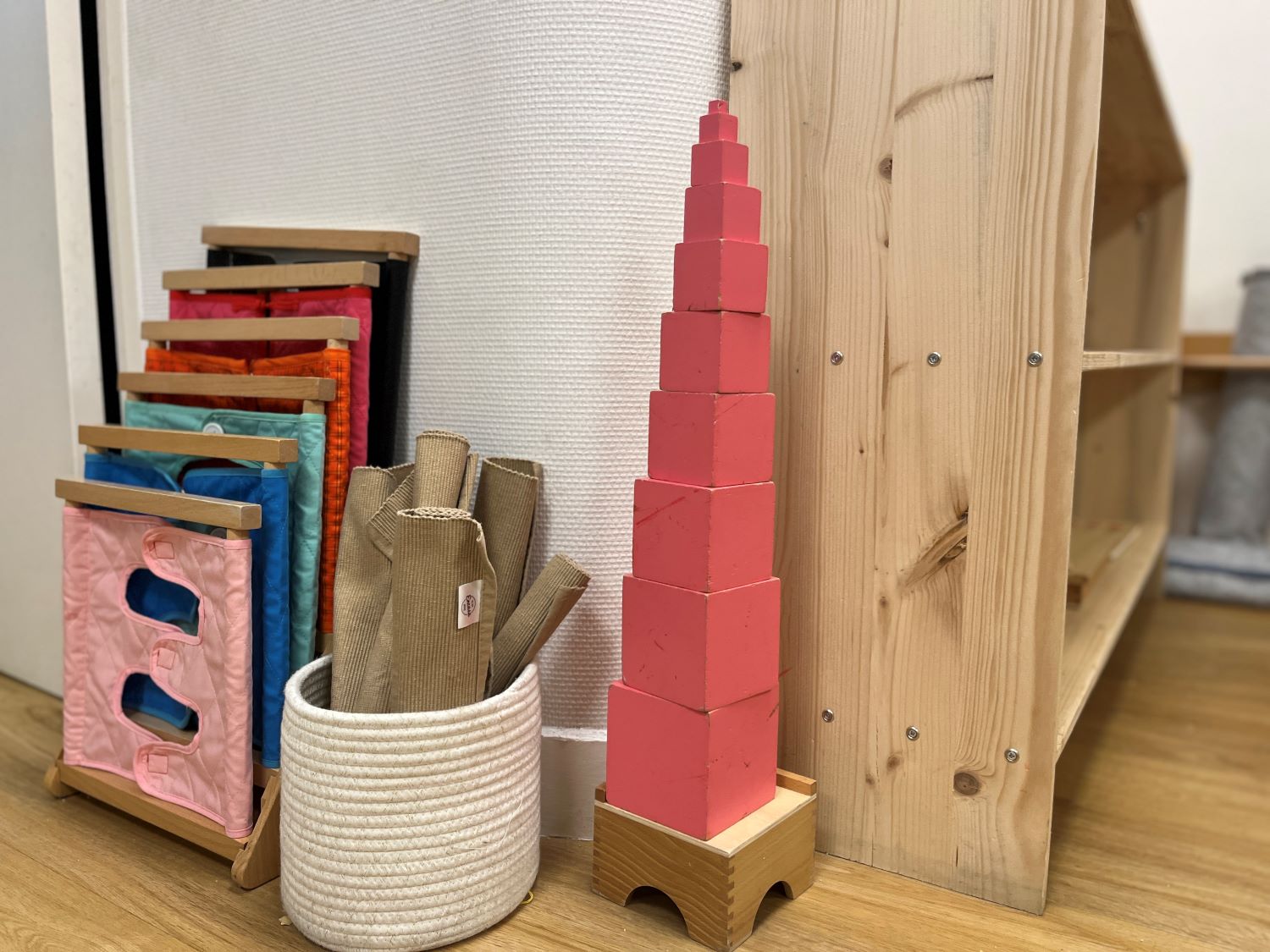Montessori
3-6 years
6-12 years
Multi-age classes and learning
February 11, 2025

The advantages of multi-age classes in Montessori schools
At school, multi-age is defined as having children of mixed ages in the same class. Multi-age classes are one of the structuring elements of a Montessori environment. Some structures welcome children from 0 to 3 years of age, sometimes with a section dedicated to the under-2s, the nido, and one for 2-3 year-olds. Then there's the 3-6 age group and the 6-12 age group, sometimes split into 6-9 and 9-12. Classes group children by developmental cycles rather than by year of birth.
Parents can be apprehensive about such an organization, often fearing that the teacher won't be able to look after their child properly, too busy with the multitude of levels. It's also a concept feared by more than one teacher. Wouldn't three different ages mean three different class preparations, and therefore three times as much work? Unfortunately, this means assuming that the model of a "homogeneous class" exists. But it's hard to find, if not non-existent.
In today's conventional school system, teachers often - more by necessity than choice - have multi-grade classes, whether or not the children are all the same age. The multi-age classroom, as conceived by Maria Montessori, is really built around specific age groups. It encourages natural learning, autonomy and cooperation cooperation between children. And these classes work extremely well. Why do they work? What benefits do they bring to children? The multi-age class is a pedagogical approach that transforms the daily school life of children and adults alike.
Why choose multi-age classes?
Unlike traditional classes where children are grouped by age, Montessori schools encourage diversity of ages and levels. Environments are adapted to the different stages of a child's development:
- 0-3 years ( Montessori nido and children's community)
- 3-6 years (kindergarten)
- 6-9 years
- 9-12 years
These age groups are not chosen at random. Maria Montessori observed that children go through sensitive sensitive periodsduring which they naturally develop certain skills. Grouping children in cycles helps to support these evolutions in a fluid and natural way, notably through peer learning and imitation.
To see an example of a theme dealt with in a multi-age group, go to our article which presents an example of aHoliday Workshop 3-6 years old on the theme of space.

The multi-age classroom: learning through observation and imitation
Children learn a great deal by observing and imitating their peers. Maria Montessori didn't wait for this concept to be named vicarious learning in 1986, following Albert Bandura's work on social learning theories. She had understood decades earlier that in a multi-age classroom, the youngest children watch the older ones attentively. Their curiosity and motivation are greatly stimulated. They want to do what they do.
"The youngest children, who naturally observe everything that's going on around them, learn a lot and are pulled up by seeing what the older ones are doing. This often gives them goals to achieve that they enjoy, because they are stimulated to do what interests them, and not pushed by an adult," explains Marie Robert, co-founder of Esclaibes International Schools.
In a Montessori kindergarten class, for example, 4-year-olds are often intrigued to see their 5-year-old classmates writing and reading their first words. They want to try, naturally, without any adult pressure. The enthusiasm is contagious. They look so happy that the younger ones are eager to get a taste of it too.
In such an environment, learning takes place gently, without comparison or competition. Each child progresses at his or her own pace, driven by a natural desire to reach the milestones set by the older children.

3 benefits of multi-age classes for younger children
Multi-age classes inevitably involve children who are younger than others. For those integrating a new atmosphere, they will :
- Evolve in a stimulating, inspiring and supportive environment: young people develop a strong sense of motivation when they see what older people can do. Learning becomes an exciting experience, with no fear of failure. What's more, the older children come to their aid when needed, and are naturally part of the effective solution to any difficulties they may encounter at school.
- Reinforce their autonomy: after watching a grown-up handle a Montessori material, a younger child can often use it without needing an explanation from the adult. This gives them greater independence and self-confidence.
"By seeing a classmate doing an activity, such as learning to read or a major operation, this goal seems easily attainable and they clearly see the steps they need to take to get there," explains Marie Robert.
- A smoother transition from one year to the next. Even the change of environment is smooth. For 3 years, children learn in the same environment. They know the rituals and activities they'll be able to do the following year. Stress is reduced. Adaptation takes place with greater serenity. The child doesn't have to worry about too much novelty. They know they won't have to adapt to a completely different way of doing things. The introduction of new tools to develop autonomy, such as the work plan, comes naturally.

What's the advantage of a multi-age class for the youngest children? When children start kindergarten for the first time, adults can spend time with them with peace of mind, because the older children are already familiar with the premises and the way things work, and can evolve independently. It's a real advantage for a calm and serene start to the new school year.
3 benefits of multi-age classes for older children
And for the older students in the atmosphere, those who finally run out of role models in their final year before changing classes, do they continue to benefit from such a scheme? The benefits are just as great and important for their development. Indeed, they know:
- A rewarding and empowering role : older children become role models for younger ones. They become aware of their influence and adopt more responsible behavior.
"The older children learn to respect the sensitivity and age difference of the younger ones. They realize that they have to set an example, because very often, the younger children will try to reproduce their attitudes. This is very rewarding for them, because they realize that they have a real role to play, an impact on other human beings. They take pleasure in helping them, accompanying them, showing them what to do," says Marie Robert.
- The pleasure of passing on : they love showing the little ones how to use a piece of equipment, explain a concept or help with an everyday task. This natural transmission strengthens their own skills and self-confidence.
- In-depth learning : by explaining to a younger child, the older child consolidates what he or she has learned. Reformulating a notion for someone else is an excellent way to anchor knowledge.

Rich and varied daily interactions thanks to a mix of ages
Mixed-age classes in no way prevent the creation of great group cohesion and common projects for the whole class. For example, in our international Montessori Esclaibes schools, as well as in our innovative middle school in Marseille, multi-age classes offer many opportunities for exchange and collaboration.
1. Sharing moments in a circle
Every day, children gather around an ellipse to discuss, listen to stories or sing together. These moments encourage mutual support and enrich the vocabulary of the youngest.
2. Inter-level meals
Joint lunches are regularly organized to allow young and old to share a convivial moment.

3. Inclusive recreation
All our schools have playgrounds. This is a prerequisite when choosing a location for an Esclaibes network school. And in these playgrounds, we encourage group games that bring young and old together. Children of all ages can play together. It's a great way to develop mutual support and respect.
4. Pair activities
For example, at our international school in Clichy, near Paris, pupils in the 6-9 age group work with those in the 3-6 age group to prepare end-of-year decorations. Pairs are formed, with the older pupils supervising the younger ones, to create a garland. This collaboration encourages creativity and teamwork.
The multi-age classroom: a caring and effective learning model
Multi-age classes are not just a feature of Montessori schools. They are a real force for children's development.
Thanks to this model, every child evolves in a caring environment, where learning takes place through observation, imitation and cooperation.
- Younger children are motivated and gain in autonomy.
- Older children develop their sense of responsibility and consolidate their skills.
- Social interactions are enriched and enhance children's well-being.
At Esclaibes bilingual Montessori schools in Paris, Clichy and Marseille, we give priority to multi-age classes. But we also adapt to the number of children in each age group. In some cases, there are so many children of the same age that the group constitutes a class in itself. Nevertheless, the way the class operates remains the same, whether the class is multi-age or not. And inter-class projects contribute to this mix of ages. At Esclaibes International Schools, we're convinced that multi-age classes enable children to learn better together, while respecting each child's pace and needs.
Would you like to find out more about our teaching methods and our Montessori classes? Contact us at!

5
Campus
+20
Nationalities
2
Teachers per class of 18 pupils
+300
Families place their trust in us

Want to give it a try?
Would you like to offer your child the opportunity to develop in one of our international schools? It's possible to book a tour of our facilities.
.svg)
OUR BLOG
You may also like

3-6 years
6-12 years

8 minutes
November 10, 2025
Individualized support at school: foundations and practices
In our schools, we draw on research in the cognitive sciences to offer learning adapted to each student.

3-6 years
6-12 years
Montessori

4 minutes
September 9, 2025
Montessori: 6 preconceived ideas to deconstruct
Untangle the truth from the false and understand Esclaibes Schools' pedagogical vision.

0-3 years
3-6 years

12 minutes
September 5, 2025
Helping children sleep
From trust to good rituals, advice from two sleep consultants

.svg)


.jpg)
.svg)
.svg)
.svg)
.svg)
